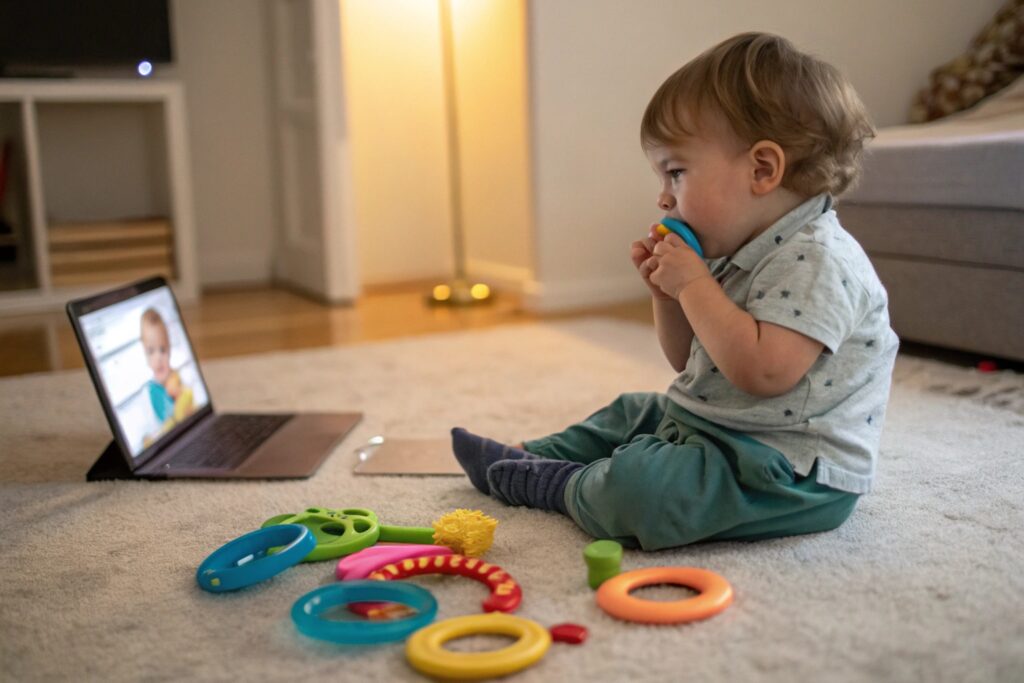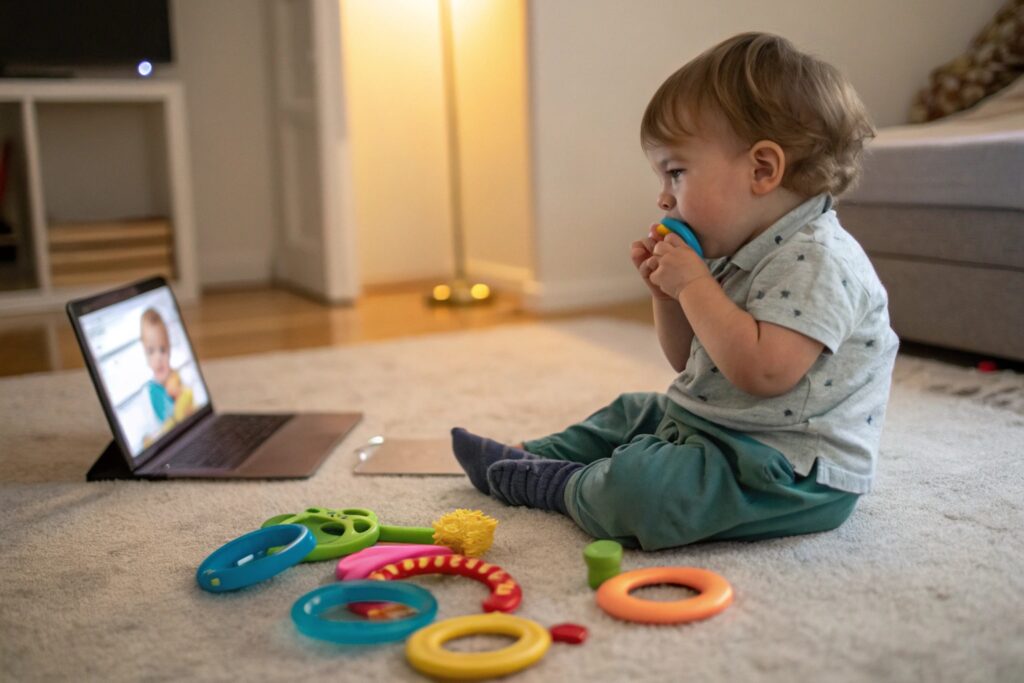You look over and notice your child chewing the collar or sleeve of their shirt again. It’s frayed, wet, and you’ve replaced it twice this month.
Children bite their shirts for sensory input, comfort, or to self-soothe during stress or overstimulation. It’s often harmless, but worth understanding.
If you’ve been wondering whether this habit is just a phase or something more, this article explains the reasons, signs, and when it might be time to seek help.
Is Shirt Biting a Sign of Anxiety in Kids?
It’s not just a habit—it can feel compulsive. Your child may bite without realizing it, especially during school, homework, or high-stress situations.
Yes, shirt biting can be a sign of anxiety in kids. It often serves as a calming strategy when they feel overwhelmed, nervous, or emotionally unsettled.

How is shirt chewing related to stress or worry?
Children don’t always have the words to say, “I feel nervous.” Instead, they use their bodies to signal their emotional state. Biting or sucking on shirts is one of those signals. Just like some adults chew on pens or nails, kids might use their clothes as a physical release for built-up tension.
These behaviors often appear during transitions—like starting school, meeting new people, or facing a test. The biting action helps them regain a sense of control. For some children, the soft pressure of fabric in the mouth is soothing, similar to how babies calm with pacifiers.
This can especially affect children with a naturally anxious temperament. They may chew when they feel uncertain, overstimulated, or emotionally tired.
When is chewing more about emotional need than physical habit?
Pay attention to the timing. If your child chews only in certain settings—like crowded classrooms or social events—it’s likely tied to emotional regulation. If biting increases when routines change or arguments happen, it’s probably anxiety-driven.
A breakdown of cues:
| Situation | Chewing Meaning |
|---|---|
| During transitions | Coping with stress or fear |
| While alone | Self-soothing or calming |
| In crowds | Emotional overload |
| When scolded | Processing shame or worry |
Understanding Sensory Behaviors in Children
Some kids aren’t anxious—they’re sensory seekers. Shirt chewing may be part of how they experience and regulate the world.
Shirt biting is often linked to sensory-seeking behaviors in children who crave oral input, texture, or pressure for comfort and focus.

What is sensory seeking, and why does it lead to shirt chewing?
Sensory seekers have nervous systems that crave stimulation. They may touch everything, make loud sounds, spin in circles—or chew. The mouth is a powerful source of sensory input. Biting on fabric gives pressure, resistance, and texture. It can feel calming or energizing, depending on the child.
Many children chew on their collars, cuffs, or drawstrings to stay alert or grounded. It’s their way of managing extra energy or staying focused. This is especially common in kids with sensory processing differences or attention challenges like ADHD.
A teacher once told me a student focused better after chewing his hoodie drawstring for a few minutes. For him, it was like flipping a “concentration switch.”
How can parents and teachers support sensory-driven chewing?
Instead of punishing or shaming the behavior, offer safe alternatives:
- Chewelry (chewable necklaces) made from silicone
- Chewable pencil toppers or hand-held fidgets
- Snack alternatives like crunchy veggies or chewable gum (if age-appropriate)
Create a supportive environment by understanding the sensory need, not just the symptom.
Comparison chart:
| Need | Behavior | Solution |
|---|---|---|
| Oral stimulation | Shirt biting | Chewelry or safe chew tools |
| Focus aid | Repetitive chewing | Structured sensory breaks |
| Self-soothing | Gentle gnawing | Soft fabric toys or stress balls |
Why Do Kids Chew Clothes Instead of Toys?
You’ve offered teething rings, plush toys, even chewy bracelets—but your child still goes for the sleeve. Why?
Kids chew clothes because they’re always accessible, familiar, and connected to comfort or routine. Clothes become a convenient tool for oral sensory regulation.

Why are shirts such a common target for chewing?
Clothes are with the child all day. Unlike toys or tools, they’re always in reach. The collar or cuff is just a head-turn or hand-lift away. For many kids, that accessibility makes shirts the go-to option.
There’s also a psychological link. Clothing carries the scent and warmth of home or the body, which adds a comforting layer. A child may associate chewing their sleeve with being safe, relaxed, or loved—especially if the habit started in early childhood or toddler years.
Some kids also enjoy the texture of specific fabrics. Cotton jersey and fleece feel soft and squishy in the mouth, offering just the right feedback they crave.
Why do some kids prefer chewing clothes even if they own chew toys?
Even if alternatives are available, chew toys can feel unfamiliar or “babyish” to older kids. They may not want to stand out at school or on the playground. Shirt chewing feels more private and less noticeable—though adults may think otherwise.
Here’s what to look for:
| Clothing Target | Likely Reason |
|---|---|
| Collars | Easily accessible and soothing |
| Sleeves | Comforting texture and habit from toddler years |
| Drawstrings | Chewing resistance or repetitive motion |
| Hoodie zippers | Texture variation or sensory pressure |
When to Worry About Kids Biting Their Shirts
Most of the time, shirt biting is just a phase. But in some cases, it may point to deeper issues.
If shirt chewing is constant, damaging, or paired with emotional distress, it’s time to consult a pediatrician or occupational therapist.

What signs suggest that chewing behavior needs professional attention?
Look for patterns. Occasional chewing isn’t a big concern. But if your child:
- Bites through fabric daily
- Damages clothes often
- Shows signs of anxiety or sensory overload
- Withdraws socially or gets teased
- Struggles with school focus or sleep
…then it’s time to explore further.
Some children chew because they’re dealing with undiagnosed conditions like:
Professionals can assess whether the behavior is part of a developmental profile or simply a coping tool. Either way, they can help you build strategies.
What steps can parents take if they’re concerned?
Start by documenting:
- When does your child chew? (time of day, setting)
- What are they doing during or before the chewing?
- How intense or frequent is it?
Then, reach out to:
- Your pediatrician
- An occupational therapist (for sensory evaluations)
- A child psychologist (for emotional screening)
In the meantime, keep calm. Avoid shaming or scolding. Offer alternatives and encourage open conversation.
Helpful action chart:
| Step | What to Do |
|---|---|
| Observe | Track when and why it happens |
| Offer Tools | Introduce safe chew items |
| Seek Help | Talk to professionals if chewing is intense |
| Support Emotionally | Acknowledge feelings behind the habit |
Conclusion
Shirt biting is often a child’s way of managing emotion or sensation. With empathy and the right support, it can be redirected into healthier habits—and understood, not judged.










